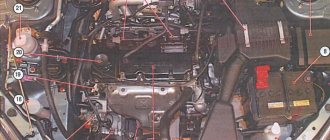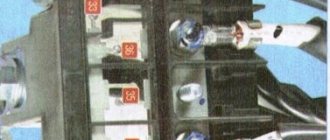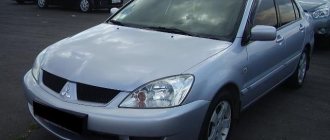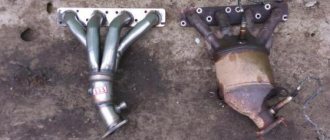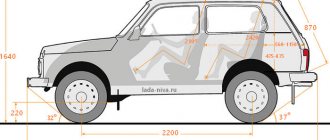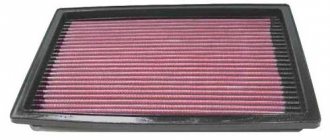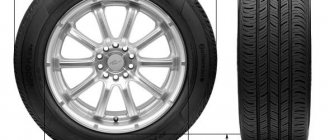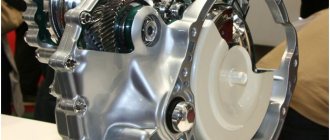Mitsubishi Lancer 9 is a popular Japanese car with low fuel consumption. True, it depends on the brand and cylinder capacity of the engine used. The most popular engine installed on the Lancer 9 was the 4G15 with a volume of 1.5 liters.
There are also versions with 4G93 (1.8 liters) and 4G94 (2 liters) engines. Depending on the engine and gearbox version, the 9th Lancer can be equipped with fuel tanks with a volume of 48-50 liters:
- popular sedans of the 6th generation (second restyling) produced in 2005 are equipped with tanks with a capacity of 50 liters,
- cars of 2003 (the first restyling) received 48 liter tanks.
Fuel consumption with 4G15 engine
The popular internal combustion engine on Japanese Lancers is 4G15 with a working cylinder capacity of 1.486 liters.
This is a classic 4-cylinder engine with 12 valves, which is distinguished by its unpretentiousness to gasoline. It works freely with AI-92 and AI-95 gasoline, and fuel consumption, according to various sources, varies from 7.5 to 8.5 l/100 km in the city; from 5.5 to 6 l/100 km – on the highway. In winter, consumption increases to 13 l/100 km. Some owners have a car with this engine that consumes 25 liters per 100 km, but in this case there is a problem. On average, 9-11 liters per 100 km in the city is a normal figure when we are talking about a Lancer based on the 4G15 engine.
Fuel consumption Mitsubishi Lancer IX 1.6i AT (98 hp)
Official data reflects the fuel consumption provided by the manufacturer of the Mitsubishi Lancer IX 1.6i AT (98 hp), it is indicated in the car’s service book, and can also be found on the manufacturer’s official website. Real fuel consumption data is based on the testimony of Mitsubishi Lancer IX 1.6i AT (98 hp) owners who left fuel consumption information on our website.
If you are the owner of a Mitsubishi Lancer
IX 1.6i AT (98 hp), and you know at least some data about the fuel consumption of your car, then you can influence the statistics below. It is possible that your data will differ from the given vehicle fuel consumption figures, in which case we ask you to immediately enter this information on the website to correct and update it. The more owners add their data on the real fuel consumption of their car, the more accurate the information obtained about the true fuel consumption of a particular car will be.
The table below shows average fuel consumption values for the Mitsubishi Lancer IX 1.6i AT (98 hp). Next to each value, the amount of data on which the average fuel consumption is calculated is indicated (i.e., this is the number of people who filled out the information on the site). The higher this number, the more reliable the data obtained.
The table below shows in sufficient detail the dependence of fuel consumption on the speed of a Mitsubishi Lancer
IX 1.6i AT (98 hp) on the highway.
Each speed value corresponds to a certain fuel consumption. If the Mitsubishi Lancer IX 1.6i AT (98 hp) has data for several types of fuel, they will be averaged and shown in the first row of the table.
The popularity index shows how popular a given car is on this site, namely, the percentage of added information about the fuel consumption of Mitsubishi Lancer IX 1.6i AT (98 hp) to the fuel consumption data of the car that has the maximum amount of added data from users . The higher this value, the more popular the car is on this project.
The position in the fuel economy car rankings for the Mitsubishi Lancer IX 1.6i AT (98 hp) is calculated based on average fuel consumption data among all cars for which information is available on the site. The lower the fuel consumption, the higher the position in the ranking of economical cars. Cars with the same fuel consumption occupy the same position.
Sources:
https://zapchasti.expert/mitsubishi/lancer-9/benzin-v-mitsubishi-lancer-9.html https://kiario.pro/technical/obem-benzobaka-kia-rio.html https://www. spirtyaga.ru/CONTENT/HOMBREW/hombrewsugar19.html https://rastop.ru/car/mitsubishi/lancer/ix/1.6i-at-98
Fuel consumption with 4G15 engine
Fuel tank volume Nissan X-Trail
The popular internal combustion engine on Japanese Lancers is 4G15 with a working cylinder capacity of 1.486 liters. This is a classic 4-cylinder engine with 12 valves, which is distinguished by its unpretentiousness to gasoline. It works freely with AI-92 and AI-95 gasoline, and fuel consumption, according to various sources, varies from 7.5 to 8.5 l/100 km in the city; from 5.5 to 6 l/100 km – on the highway.
In winter, consumption increases to 13 l/100 km. Some owners have a car with this engine that consumes 25 liters per 100 km, but in this case there is a problem. On average, 9-11 liters per 100 km in the city is a normal figure when we are talking about a Lancer based on the 4G15 engine.
How the fuel tank works
The Kia Rio gas tank is made of aluminum alloy. Two stamped halves are welded into a single whole and a sealed container emerges. The device is equipped with the following products:
- fuel filler pipe;
- fuel filter;
- fastening tape;
- high pressure fuel pump;
- fuel pipe.
Many articles have been written on the Internet about tank removal, including step-by-step instructions for dismantling. Brief repair tips are given below.
Mitsubishi Lancer nine with ICE 4G92 and 4G93
Volkswagen Polo fuel tank volume: let's describe the main thing
4G93 engines were installed on 6th generation Lancers. They are 1.8-liter power units with a capacity of 100 10 hp. (atmospheric) and 100 50 hp. (with turbine). In fact, these engines are the same 1.5-liter internal combustion engines, but with a bored out cylinder block and larger pistons in diameter.
It is recommended to fill them with AI-95 and AI-98 gasoline, but AI-92 is also allowed. Note that although residents of the land of the rising sun indicate in the properties gasoline with an octane number of ninety-two as acceptable for use on 4G93, they do not need to pour it into the tank due to the fact that the situation with control of fuel properties is worse than in European countries and even more so in the Land of the Rising Sun.
Versions and configurations
What is the tank on a Duster made of? Renault Duster fuel tank volume
Lancer 9th generation combines many useful functions and qualities. The car has two popular versions - 1.3-liter and 1.6-liter. The sports modification, equipped with a 2-liter unit, is designed for amateurs. “Russian” Lancer 9 was also offered in three versions: 1.3, 1.6 and 2.0 – all with gasoline internal combustion engines. Both sedans and station wagons sold well.
Sedans
Technical characteristics of the Mitsubishi Lancer 9 sedan
Regarding the sedan trim levels, the following picture emerges:
- The 82-horsepower 1.3-liter engine was equipped only with the Invite-MT package. The engine brand was called 4G13, and the body brand was CS1A. Years of production: from August 2003 to May 2009. Wheel drive is front-wheel drive.
- The Invite-MT package was also equipped with a 1.6-liter internal combustion engine in the same body brand. Lancer 9 of this version accelerated to 100 km/h in 13.6 seconds. Fuel consumption – 6.7 liters.
- A 98-horsepower 1.6-liter power unit was equipped with a package called Invite-MT Special, released from April 2007 to June 2007. The car developed a speed of 183 km/h, differed from other versions (for example, Invite Plus) in low consumption - 6.7 l/100 km versus 7.9 l/100 km - a noticeable difference. The gearbox is mechanical with 5 speeds, when the standard configurations of the Invite 1.6 were equipped with a 4-speed manual transmission.
- The same engine was installed on the Invite Plus with a manual transmission, and on the AT and AT-plus with an automatic transmission. A model with a 4-speed automatic transmission, produced from March 2006 to May 2009, consumed 7.9 liters of fuel per 100 km. Considering the presence of an automatic transmission, this consumption can be considered not very high.
- The Instyle-MT and Instyle-AT configurations were equipped with a 1.6-liter engine. Both versions were produced from August 2003 to May 2009. The consumption of the version equipped with a manual transmission was 6.7 l/100 km, and the version with an automatic transmission was 7.9 l/100 km. The 5-speed manual accelerated to 100 km/h in 11.8 seconds, and the automatic in 13.6 seconds. It is noteworthy that with a manual it was possible to accelerate to 183 km/h, and with an automatic – only up to 176 km/h.
- The top trim levels Intens-MT and Intens-AT were equipped with a larger 2.0 liter 4G63 engine. Intens-MT was published from August 2003 to May 2009. Intens-AT - from March 2006 to May 2009. The consumption of the manual version is 8.4 l/100 km, the automatic version is 9 liters. The automatic transmission version was also inferior in maximum speed: Lancer 9 with a manual transmission could accelerate to 204 km/h, and to 187 km/h with an automatic transmission.
Thus, three brands of engines 4G13, 4G18 and 4G63 were installed on the 9th generation Lancer. The latter is the destiny of the top Intens configurations.
The engines also had different power levels: 4G13 developed 82 hp. pp., 4G18 – 98 l. s, and 4G63 – 135 hp. With.
Mitsubishi Lancer 9 technical specifications 2.0 Intens-AT
| Release period | March 2006 - May 2009 |
| checkpoint | Automatic 4 |
| Engine capacity, cc | 1997 |
| Body brand | CS1A |
| Acceleration time 0-100 km/h, s | 12 |
| Ground clearance (ride height), mm | 155 |
| Maximum speed, km/h | 187 |
| Body dimensions (L x W x H), mm | 4535 x 1715 x 1435 |
| Wheelbase, mm | 2600 |
| Permissible total weight, kg | 1770 |
| Fuel tank volume, l | 50 |
| Engine make | 4G63 |
| Fuel consumption in the combined cycle, l/100 km | 9 |
Station wagons
Technical characteristics of Mitsubishi Lancer 9 station wagon
The 9th generation Lancer station wagons were not produced for long. They came straight from the Mizushima automaker.
Station wagons were equipped with only two engines: a 98-horsepower 1.6-liter 4G18 and a 135-horsepower 2.0-liter 4G63. The boxes were installed mechanical and automatic. The station wagon body brand was called CS3W.
Station wagon configuration:
- Invite-MT was equipped with a 98-horsepower 1.6-liter engine. Years of production: June 2005-February 2009. Fuel consumption in mixed mode is 7 liters per 100 km. 5-speed manual transmission. The version had a top speed of 181 km/h.
- Invite plus MT/AT was also equipped with a 98-horsepower internal combustion engine, but began to appear two years later - in 2007. The gearbox in this configuration could be manual or automatic. Fuel consumption: manual transmission - 7 liters, automatic transmission - 8.2 liters. The “mechanical” Invite Plus accelerated to 181 km/h, the “automatic” - to 175 km/h.
- The Instyle-MT/AT package has been produced since 2003. Equipped with a 98-horsepower engine. Consumption of manual – 7 l/100 km, automatic – 8.2 l/100 km. Acceleration to 100 km is 12.6 s, automatic – more.
- The top-end Intens-MT package was equipped with a 135-horsepower 2-liter power unit. The gearbox is manual only. Years of production: June 2005 - February 2009. Fuel consumption - 8.6 liters, acceleration time to 100 km/h - 10 seconds, maximum speed - 199 km/h.
Characteristics of cars with various power plants
The best efficiency is shown by the Mitsubishi Lancer X 1.5 mt. Average gasoline consumption when driving in mixed mode is about 6.5 liters per 100 km. When driving in cities, fuel consumption increases to 8.2 liters. Going on the highway will be accompanied by the lowest consumption, which is no more than 5 liters.
Using an automatic transmission on the Mitsubishi Lancer 10 1.5 atm increases fuel consumption. For 100 kilometers on the highway you will need 6 liters. In city traffic the car will consume 8.9 liters. In the case of mixed driving mode, fuel consumption will be about 7 liters. Acceleration to hundreds will range from 11.2 for manual to 15.3 in the case of at.
With 1.6-liter engines, a classic 4-speed automatic gearbox and a 5-speed manual transmission are used. The Lancer 10 sedan with such an engine has the characteristics shown in the table below.
Characteristics table for Mitsubishi Lancer 10 with 1.6 liter engine
The engine capacity of 1.8 liters contributes not to economical, but to dynamic driving.
Characteristics table of Mitsubishi Lancer X with 1.8 liter power plant
A wide variety of Lancer X cars are produced with 2.0 liter engines. This includes 4wd all-wheel drive and sporty ralliart cars, the production of which has been launched since 2008. Gasoline consumption per 100 kilometers for various Lancer 10 models is shown in the table below.
Fuel consumption table for Mitsubishi Lancer X 2.0 in various versions
Acceleration to 100 kilometers per hour using the 2.0 engine was achieved in less than 10 seconds. The characteristics of the engine and gearbox are tailored to the maximum to achieve the best dynamics.
Choosing gasoline in Mitsubishi Lancer 9
Mitsubishi Lancer 9 is a popular Japanese car with low fuel consumption. True, it depends on the brand and cylinder capacity of the engine used. The most popular engine installed on the Lancer 9 was the 4G15 with a volume of 1.5 liters.
There are also versions with 4G93 (1.8 liters) and 4G94 (2 liters) engines. Depending on the engine and gearbox version, the 9th Lancer can be equipped with fuel tanks with a volume of 48-50 liters:
- popular sedans of the 6th generation (second restyling) produced in 2005 are equipped with tanks with a capacity of 50 liters,
- cars of 2003 (the first restyling) received 48 liter tanks.
How much does the subcompact version consume?
If you are one of those who prefer to save on servicing a Lancer, purchase a modest and low-power 1.3 liter version with an engine of just 83 horsepower. Statistics for this configuration indicate that, according to official data, again, a car with such an engine should “eat” a maximum of 8.6 liters. Having turned to the owners for feedback, we find that in reality it comes out to 9.63 when driving around the city. If you have your own excellent data, write to us.
With this we will say goodbye, friends. There are many other useful discussions ahead of us regarding fuel consumption of other car brands, and not only. Subscribe to the blog and stay up to date with events. Bye!
Choosing gasoline in Mitsubishi Lancer 9
Mitsubishi Lancer 9 is a popular Japanese car with low fuel consumption. True, it depends on the brand and cylinder capacity of the engine used. The most popular engine installed on the Lancer 9 was the 4G15 with a volume of 1.5 liters.
There are also versions with 4G93 (1.8 liters) and 4G94 (2 liters) engines. Depending on the engine and gearbox version, the 9th Lancer can be equipped with fuel tanks with a volume of 48-50 liters:
- popular sedans of the 6th generation (second restyling) produced in 2005 are equipped with tanks with a capacity of 50 liters,
- cars of 2003 (the first restyling) received 48 liter tanks.
Engine design Lancer 9 1.6 l.
Popular reviews from owners of Mitsubishi Lancer up to 1.5 liters, automatic with photo
The Mitsubishi 4G18 engine with a volume of 1.6 liters appeared in the process of modernizing and increasing the displacement of the base 4G13 engine with a volume of 1.3 liters, which was developed back in 1983. But before the 1.6 liter version there was a 1.5 liter 4G15 model; the 1.5 and 1.6 liter Mitsubishi engines are structurally identical. The difference in working volume is only due to the different piston stroke. But we will not delve into the history of the formation of this motor.
Mitsubishi Lancer 9 has under the hood an inline 4-cylinder 16 valve engine with a cast iron block and a timing belt. A design feature can be called SOHC V16 - an overhead camshaft with 16 valves. The Delphi MT20U2 electronic engine management system is a multi-point fuel injection system, direct ignition without the use of a distributor.
Lancer 9 1.6 l engine cylinder head.
The Mitsubishi Lancer 9 cylinder head has a rather interesting design. The camshaft is inserted inside the head, which is a large bearing housing for the camshaft. The camshaft cams run onto rocker arms, which are mounted on top and secured to common axles. Until a certain moment, this design did not have hydraulic compensators. To adjust the gap, it was necessary to rotate a special adjusting bolt and nut. But a little later, hydraulic compensators were introduced into the design. The bulk of cars that were sold in Russia through official dealers have hydraulic compensators.
Characteristics and malfunctions of motors
| Type | Volume | Power | Torque | Overclocking | Maximum speed | Number of cylinders |
| Petrol | 1.3 l | 82 hp | 120 H*m | 13.7 sec. | 171 km/h | 4 |
| Petrol | 1.6 l | 98 hp | 150 H*m | 11.8 sec. | 183 km/h | 4 |
| Petrol | 2.0 l | 135 hp | 176 H*m | 9.6 sec. | 204 km/h | 4 |
More details
For Russia, the engine line of the ninth Mitsubishi Lancer consists of three gasoline engines, although the entire line is not much more extensive.
- 4G13 is the base old 1.3-liter MPI engine, producing 82 horsepower with 120 H*m of torque. The dynamics of the engine are clearly not enough, and fuel consumption usually starts from 8.5 liters.
- 4G18 is the most popular 16-valve 1.6-liter engine with a capacity of 98 horsepower and 150 units of torque. The dynamics have somehow become acceptable, while fuel consumption rises by only half a liter.
- 4G63 is a rare 2-liter naturally aspirated engine that produces 135 horsepower and 176 units of torque. With it, the sedan comes to life (not a sport, of course), but you will have to put up with at least 12-liter city fuel consumption.
The 1.3-liter engine will last a maximum of 300 thousand, then it will require capital or replacement. The belt needs to be changed every 90,000 km, along with adjusting the valve clearances. Among the problems is the poor design of the Lancer throttle valve, due to which the idle speed fluctuates. The throttle is changed to modified ones.
After 200 thousand, the piston rings become stuck, causing heavy oil consumption and even cylinder scuffing.
The 1.6-liter unit is identical to the base one, and therefore has identical problems. Plus, everyone complains about high oil consumption, which occurs due to a weak cooling system. Overheating appears after 100 thousand, which leads to ring jamming, and by 200 thousand the engine runs on constantly new oil, due to constant topping up. By 250 thousand, a major overhaul of the 4G18 will be required.
In winter, the engine loses its thermostat. Don’t be alarmed, engine parts are relatively cheap, and you can do the work yourself.
The 2-liter engine with two camshafts already has hydraulic compensators, which eliminates the need to adjust the valves. The engine turned out to be more reliable, lasting 400 thousand kilometers. It is considered the best of the manufacturer’s entire line, and even some companies produce it under license.
Engines
The European Mitsubishi Lancer was equipped with three gasoline engines with a displacement of 1.3, 1.6 and 2.0 liters. The smallest motor is a real misunderstanding. Even the 1.6-liter unit with 98 hp. does not allow you to confidently move on the highway. In addition, it consumes no less fuel than a 2-liter naturally aspirated one. 2.0 DOHC with 135 hp output. one of the best engines in Mitsubishi history.
In addition to these units, the Lancer was available in the US and Japan with 1.5 L, 1.8 L and 2.4 L engines equipped with MIVEC variable valve timing. Diesel engines are completely absent from the model’s range.
Power units, for the most part, do not require attention, with the exception of regular replacement of fluids and filters, as well as flushing the throttle valve. Contamination that progresses over time leads to uneven engine idling. Sometimes the idle air control also fails. In some cases, an oil leak is detected through the crankshaft seals or the oil pump sealing ring.
Oxygen sensors (lambda probes), generator, starter and fuel pump fail at high mileage (after 200-300 thousand km). From time to time you have to deal with a faulty cooling system fan control unit (from 1,500 rubles for an analogue).
However, 1.6-liter engines often begin to eat up oil at 150-200 thousand km. Great luck if you managed to get away with just replacing the valve stem seals (5,000 rubles including labor). Most often, you also have to change the rings (20,000 rubles). And after 100-150 thousand km everything repeats itself. After the second replacement of the rings, major repairs are almost inevitable - 50-60 thousand rubles.
Sometimes the 1.3-liter naturally aspirated engine also fails. After 200-300 thousand km, wear of the camshaft cams is detected.
Other problems and malfunctions
Lancer “loves” corrosion, but not excessively. Mitsubishi, like many Japanese manufacturers of the time, applied a very thin layer of poor quality varnish to the car. Therefore, numerous scratches, chips and corrosion of bare metal are quite an expected picture. However, few Lancers are painted in an expensive and rich color, and therefore cosmetic repairs will be inexpensive. More often the problems concern the rear wheel arches.
The materials used for interior decoration may seem unattractive and of low quality. But this is just an illusion. The resistance of interior parts to wear is high. The salon doesn't bother you with squeaks either.
In winter, the rear door locks often freeze. In the future, the lock actuators may fail. A new motor-actuator can be found for 300 rubles
After 150,000 km, the heater fan sometimes starts working only in the 4th speed position. The heater resistor fails (5,000 rubles). One of the reasons is the motor jamming due to contamination and lack of lubrication.
Soon you may also need to replace the steering column cable (from 1,500 rubles).
9th generation Mitsubishi Lancer equipment
Motor Mitsubishi Lancer
features a wide rev range in everyday driving. Modern engines use light alloys that reduce the weight of the structure and a 16-valve gas distribution system. Thanks to this, the engine is economical and low toxic.
Below is a list of engines with their features:
- Power unit with a volume of 1.6 liters. and a power of 98 hp. capable of developing a torque of up to 150 N/m and is well elastic, making driving in the city very easy and eliminating the need for the driver to frequently downshift.
- 1.3 liter engine. and 82 hp. provides smooth acceleration.
- Engine with a volume of 2 liters and a power of 135 hp. gives the sports version an explosive temperament, and the five-speed gearbox with easy shifting allows you to get maximum pleasure from the driving process;
- Together with a 1.6 liter engine. you can install a 4-speed sequential gearbox, which will provide a more dynamic ride. This box has built-in intelligence that remembers your driving style and then automatically changes gears in a style that suits you. A special Sport Mode allows you to manually change speeds;
The Lancer's reliable chassis provides reliable grip on any road surface, regardless of whether it is gravel, country roads, asphalt or icy roads. The car is equipped, which provides a convenient combination of comfort and stability along the course.
Mitsubishi Lancer 9 with ICE 4G92 and 4G93
Old 5th generation models from 1992-2000 were equipped with 1.6-liter 4-cylinder 4G92 engines. According to owner reviews, gasoline consumption on this engine is 6-7 l/100 km on the highway, 11-12 l/100 in the city. In the combined cycle it takes about 8-9 liters per hundred, which is an acceptable value. The differences from version 4G15 are minimal or non-existent.
4G93 engines were installed on 6th generation Lancers. They are 1.8-liter power units producing 110 hp. (atmospheric) and 150 hp. (with turbine). Essentially, these engines are the same 1.5-liter internal combustion engines, but with a bored out cylinder block and larger pistons in diameter.
It is recommended to fill them with AI-95 and AI-98 gasoline, but AI-92 is also allowed. Note that although the Japanese indicate in the specifications gasoline with an octane rating of 92 as acceptable for use on 4G93, it is undesirable to pour it into the tank due to the fact that in Russia things are worse with fuel quality control than in European countries, and even more so in Japan.
How much does the subcompact version consume?
If you are one of those who prefer to save on servicing a Lancer, purchase a modest and low-power 1.3 liter version with an engine of just 83 horsepower. Statistics for this configuration indicate that, according to official data, again, a car with such an engine should “eat” a maximum of 8.6 liters. Having turned to the owners for feedback, we find that in reality it comes out to 9.63 when driving around the city. If you have your own excellent data, write to us.
https://youtube.com/watch?v=J4N4hHsD9PM
With this we will say goodbye, friends. There are many other useful discussions ahead of us regarding fuel consumption of other car brands, and not only. Subscribe to the blog and stay up to date with events. Bye!
Views:10870
3likes
Reasons for increased gasoline consumption
Not a single service station technician will tell you why gasoline is being wasted without preliminary diagnostics. The problem may lie in the internal combustion engine itself, or in the fuel supply system, injector, carburetor (9th Lancers can have one of two power systems).
Often, owners simply operate engines incorrectly, which leads to increased consumption:
- constant stops in the city, sudden starts,
- intensive acceleration when overtaking,
- driving at consistently high speeds, using winter tires in the warm season (and vice versa),
- deflated wheels,
- untimely replacement of oil and other consumables - this causes increased fuel consumption.
Technical problems faced by Mitsubishi Lancer 9 owners:
- Clogged injectors, which leads to incorrect injection. The solution is to clean them or replace them.
- Incorrect operation of the fuel pump, due to which the pressure in the fuel system “jumps”. This results in an incorrectly proportioned fuel-air mixture.
- Exhaust gas recirculation (EGR) valve clogged. Through it, part of the exhaust gases is returned back to the engine, and this operation is controlled by the ECU, which opens and closes the valve. Over time, soot accumulates on it, and this leads to jamming of the valve. Then, during the entire operating time, a “porridge” of air, exhaust gases, and gasoline enters the combustion chamber - such a mixture is ineffective, and this leads to increased consumption. The solution is to clean the valve from burning and soot. This operation is even prescribed in the technical passport for some cars as a mandatory maintenance measure.
- Oil of incorrect viscosity or poor quality, which leads to increased friction between the pistons and cylinder walls.
- Oxygen sensor (lambda probe). Some Lancer owners overcome overspending only after replacing the lambda probe. This sensor determines the amount of oxygen in the exhaust and, based on this information, the ECU optimizes the mixture composition, supplying more or less fuel to the cylinders. Incorrect operation of the oxygen sensor increases the “appetite” of the engine.
In fact, there are many more reasons, and sometimes a whole complex of problems leads to increased consumption.
Mitsubishi Lancer 9 is not the most economical car. They received efficient and reliable engines with a service life of 250+ thousand kilometers, but they cannot be praised for their record low “appetite”.
Speed indicators and consumption
To accelerate to one hundred kilometers, models for the Russian market (hatchbacks, sedans) spend from 7 to 14.3 seconds, European ones - from 7 to 11.9 seconds. The American and Japanese versions have approximately identical indicators. Maximum speed from 178 to 207 kilometers per hour. The sports version can accelerate to 230 km/h.
Average fuel consumption per hundred kilometers in Russian models is:
- sedans 2011-2016 – 6.2/6.4/7/7.3/7.7/7.9;
- hatchbacks 2007-2010 – 7.9/10.2;
- sedans 2007-2011 – 6.4/7/7.7/7.9/8.1/8.4/8.4/8.8/10
The manufacturer recommends using only 95 gasoline.
In Japanese station wagons, the average consumption is:
- 2017-2019 – 5,7/7,7;
- 2008-2017 – 5,7/6,2/6,3/7,2/7,7.
They can use Regular fuel with octane ratings of 92 and 95.
European models consume:
- sedans 2016-2017 – 5.5/6.6;
- sedans 2016-2017 – 5.5;
- hatchbacks 2011-2016 – 5.1/5.5/6.6;
- sedans 2011-2016 – 4.8/5.5;
- hatchbacks 2007-2011 – 6.3/7.9/8/10.2;
- sedans 2007-2011 – 6.1/7.7/7.9/10.
95 gasoline is recommended, there are models with a diesel engine.
American models have average gas mileage:
- sedans 2015-2017 – 7.8/8.4/8.7/9/9.4;
- sedans 2015-2017 – 8.1/8.49/9.4/11.8;
- hatchbacks 2007-2013 – 8.7/9/9.4/10.7/11.7/11.8/13.8;
- sedans 2007-2012 – 8.4/9/10.2/10.6/10.7/11.2/11.7/11.8/12.3/13.8.
AI-95 fuel is recommended for these models. The consumption of gasoline and diesel completely depends on the characteristics of the car, engine, driving style, vehicle load, technical condition and some other factors.
Interior and exterior features
The Mitsubishi Lancer station wagon has a stylish interior that contains features of both business and sports style. The seats are reminiscent of racing seats, while the upholstery is made in a strict design style, allowing the driver to concentrate directly on the track.
The on-board electronic system is equipped with all the functions necessary for a modern motorist and, if desired, can be significantly upgraded. The exterior design of the Lancer 9 is distinguished by its characteristic sporting orientation; the style itself allows it to be recognizable among a large number of prototypes.
Being in the cabin of the Mitsubishi Lancer station wagon 9 is convenient for both the driver and the passengers. All seats are easily adjustable if desired, if practical need arises.
The hum of the engine and noise from the external environment inside the cabin are almost imperceptible, which makes traveling in a car extremely comfortable, regardless of the conditions that exist at a given time.
Video in this article: Getting to know Lancer 9
Peculiarities
It's essentially a regular compact, but a little different than the others. It was never offered as a hatchback, which was one of the reasons for the lack of interest in Europe.
Mitsubishi Lancer has a fairly long wheelbase - 2600 mm. Like modern Golf cars, Lancer 9 is quite spacious inside. Even rear seat passengers can't complain about the lack of space. The 430-litre trunk won't disappoint either.
Lancer, apart from the independent rear suspension, does not stand out from its competitors in anything special. When creating it, fairly simple design solutions were used. Even the independent rear suspension is simple compared to similar designs. It’s better to forget about advanced multimedia systems right away.
The front panel is so primitive that it seems that the stylists were devoid of imagination. But for those who value simplicity, you won't find a better dashboard in this segment.
Due to the small number of switches, it seems that the car is very poorly equipped. Mitsubishi offered only the bare minimum: two airbags, electrically operated windows and mirrors, and air conditioning. There was also ABS. However, in the sports version you will be fascinated by the steering wheel, aluminum inserts, real sports indicators from the Evo version, leather upholstery and very comfortable seats with developed lateral support.
The biggest advantage of this car is its obedience on the road. There is an opinion among drivers that the Lancer behaves so well that the ESP system is a waste of money. Few people know that in independent tests, the Japanese sedan proved to be no worse than the reference Ford Focus. Unfortunately, it cannot compare with the Focus in terms of comfort. Although a lot depends on the version and configuration. The most interesting is the Sport version with a slightly lowered suspension and 16-inch low-profile tires. This car is relatively stiff, but it drives excellently.
Lancer history
Pioneer
One of the most famous, successful and sought-after Mitsubishi series is Lancer. The first swallow of the line - the A70 model - saw the world at the end of winter 1973. It was produced in the following body styles:
- sedan with 2 doors;
- sedan with 4 doors;
- station wagon with 5 doors.
Generation number two
In 1979, a new Lancer series appeared - EX. At first it was equipped with engines that could have three displacement options:
- 1.4 l (power - 80 horsepower);
- 1.6 l (85 horsepower);
- 1.6 l (100 horsepower).
But, a year later, another Lancer model appeared in the lineup with a more powerful engine - 1.8 liters. In addition, sports cars with other engines were produced.
In terms of fuel consumption, even the second generation Mitsubishi Lancer was very economical. The fuel consumption test, which passenger cars underwent in ten modes, showed fuel consumption of only 4.5 liters per 100 kilometers
. Well, if the Lancer owner drove mainly at a speed of 60 km per hour, then the fuel consumption was 3.12 liters per 100 km.
Third knee
The car of the third “level” appeared in 1982 and was called Lancer Fiore, had two body options:
- hatchback (since 1982);
- station wagon (since 1985).
Such Lancers were produced until 2008. A feature of this line was that the cars began to be equipped with turbocharging, as well as an injector. Like the previous ones, they were equipped with engines of different sizes, on which fuel consumption depended:
- 1.3 l;
- 1.5 l;
- 1.8 l.
Fourth generation
From 1982 to 1988, the fourth “circle” was updated. Externally, these cars began to be distinguished by the presence of diagonal lights. Engine modifications were as follows:
- sedan, 1.5 l;
- sedan, 1.6 l,
- sedan, 1.8 l;
- sedan diesel;
- station wagon, 1.8 l.
Attempt number five
Already in 1983, a new Lancer model appeared. Outwardly, she became much more interesting than her predecessors and almost immediately gained enormous popularity. The car was produced in four body styles:
- sedan;
- hatchback;
- station wagon;
- coupe.
Also, the future owner could choose the desired engine size:
- 1.3 l;
- 1.5 l;
- 1.6 l;
- 1.8 l;
- 2.0 l.
The gearbox could be 4 or 5 speed. Also, some models were produced with a three-speed automatic transmission, which greatly simplified driving.
Mitsubishi Lancer 9 with ICE 4G92 and 4G93
Old 5th generation models from 1992-2000 were equipped with 1.6-liter 4-cylinder 4G92 engines. According to owner reviews, gasoline consumption on this engine is 6-7 l/100 km on the highway, 11-12 l/100 in the city. In the combined cycle it takes about 8-9 liters per hundred, which is an acceptable value. The differences from version 4G15 are minimal or non-existent.
4G93 engines were installed on 6th generation Lancers. They are 1.8-liter power units producing 110 hp. (atmospheric) and 150 hp. (with turbine). Essentially, these engines are the same 1.5-liter internal combustion engines, but with a bored out cylinder block and larger pistons in diameter.
It is recommended to fill them with AI-95 and AI-98 gasoline, but AI-92 is also allowed. Note that although the Japanese indicate in the specifications gasoline with an octane rating of 92 as acceptable for use on 4G93, it is undesirable to pour it into the tank due to the fact that in Russia things are worse with fuel quality control than in European countries, and even more so in Japan.
Mitsubishi Lancer 1.8i CVT – fuel consumption per 100 km
- City cycle: 10.9 l
- Extra-urban cycle: 6.2 l
- Combined cycle: 7.9 l
The production of Mitsubishi Lancer can safely be called more than successful. Just think about the fact that today the tenth generation of this series is being produced. This can only be explained by the enormous popularity and incredible demand for such cars.
The model has some design similarities with sports cars
To verify this, just pay attention to the rear of the Mitsubishi Lancer. Among the shortcomings, it is worth noting that the trunk size is not very spacious
Therefore, if you are looking for a vehicle for traveling with the whole family outside the city and for transporting a large number of things, then the Mitsubishi Lancer is not the most suitable option.
The engine capacity is 1.8 liters. At the same time, it is complemented by a manual or automatic transmission at your discretion. It is worth noting here that if problems arise with automation, there will be much more hassle than with simple mechanics. Therefore, it is not surprising that manual transmission is more popular.
The engine power is equivalent to 143 horsepower, and in order to accelerate the car to 100 km/h, you need to spend 11.7 seconds.
The Mitsubishi Lancer is an exclusively front-wheel drive car with a very comfortable suspension. In our off-road conditions, the latter fact is of great importance.
The car interior is quite spacious and comfortable. There is more than enough space for both the driver and passengers inside the Mitsubishi Lancer.
Reasons for increased gasoline consumption
Not a single service station technician will tell you why gasoline is being wasted without preliminary diagnostics. The problem may lie in the internal combustion engine itself, or in the fuel supply system, injector, carburetor (9th Lancers can have one of two power systems).
Often, owners simply operate engines incorrectly, which leads to increased consumption:
- constant stops in the city, sudden starts,
- intensive acceleration when overtaking,
- driving at consistently high speeds, using winter tires in the warm season (and vice versa),
- deflated wheels,
- untimely replacement of oil and other consumables - this causes increased fuel consumption.
Reasons for increased gasoline consumption
Not a single 100% master without preparatory diagnostics will be able to say why gasoline is being consumed. The problem may lie in the internal combustion engine itself, as well as in the fuel supply system, injector, carburetor (9 Lancers can have one of two power systems).
Often, owners simply operate engines incorrectly, which leads to increased consumption:
- constant stops in the town, sudden starts,
- intense acceleration when overtaking,
- driving at moderately high speeds, introducing winter tires in the warm season (and vice versa),
- deflated wheels,
- Failure to change oil and other consumables in a timely manner causes increased fuel consumption.
Technical difficulties faced by Mitsubishi Lancer 9 owners:
- Clogged injectors, which leads to incorrect injection. The solution is to clean them or replace them.
- Incorrect operation of the fuel pump, due to which the pressure in the fuel system fluctuates. This results in a fuel-air mixture with the wrong proportions.
- Exhaust gas recirculation (EGR) valve clogged. Through it, part of the exhaust gases returns back into the engine, and this operation is controlled by the ECU, which opens and closes the valve. Over time, soot accumulates on it, and this leads to jamming of the valve. Then a mixture of air, exhaust gases, and gasoline enters the combustion chamber during the entire operating time; such a mixture is ineffective, and this leads to increased consumption. The solution is to clean the valve from burning and soot. This operation is even prescribed in the technical passport for some cars as an essential maintenance measure.
- Oil of incorrect viscosity or low quality, which leads to increased friction between the pistons and cylinder walls.
- Oxygen sensor (lambda probe). Some Lancer owners experience overspending only after replacing the lambda probe. This sensor determines the amount of oxygen in the exhaust and, based on this information, the ECU improves the composition of the mixture, supplying more or less fuel to the cylinders. Incorrect operation of the oxygen sensor increases the engine's appetite.
In fact, there are even more circumstances, and from time to time a whole complex of problems leads to excessive consumption.
Mitsubishi Lancer nine is not the most economical car. They received efficient and reliable engines with a service life of two hundred and 50 thousand km, but they cannot be praised for their record-breaking appetite.
Choosing gasoline in Mitsubishi Lancer 9
Mitsubishi Lancer nine is a popular Japanese car with low fuel consumption. True, it depends on the brand and cylinder capacity of the engine used. The most popular engine installed on the Lancer 9 was the 4G15 with a volume of 1.5 liters.
There are also versions with 4G93 (1.8 liters) and 4G94 (2 liters) engines. Depending on the version of the engine and gearbox, the 9th Lancer can be equipped with fuel tanks with a volume of 48-50 liters:
- the popular 6th generation sedans (2nd restyling) two thousand of the 5th year of production are equipped with tanks with a capacity of 50 liters,
- cars two thousand three years old (1st restyling) received tanks of 40 eight liters..
Automatic transmission and 2-liter version are his appetites
The situation is also disappointing with the automatic transmission. You can safely add 1.5–2 liters to reach real values. Some owners note the appetites of their Lancer, reaching up to 15 liters! The 2.0 liter version of the Japanese car is even capable of bankrupting the owner. Fuel consumption is up to 13 liters, based solely on the car’s passport data. On the highway the car consumes less, up to about 8.5–8.6 liters.
In many ways, the consumption component, in other words, the car’s gluttony, is influenced by the driving method that the driver prefers. Some are reckless and start from a standstill, and what kind of consumption can you expect in this case? Yes, yes to very high)
And now the data provided by the manufacturer.
| Engine and transmission | Fuel consumption in the urban cycle, l/100km | Fuel consumption in the extra-urban cycle, l/100km | Fuel consumption in the combined cycle, l/100km |
| 1.3 (82 hp) manual transmission | 8,5 | 5,3 | 6,5 |
| 1.6 (98 hp) manual transmission | 8,8 | 5,5 | 6,7 |
| 1.6 (98 hp) automatic transmission | 10,3 | 4,4 | 7,9 |
| 2.0 (135 hp) manual transmission | 11,7 | 8,4 | 6,5 |
| 2.0 (135 hp) automatic transmission | 12,6 | 9 | 6,9 |
How much does the most common version of Lancer “eat”?
This car model, especially in the 1.6 liter engine version, is one of the quite common ones on domestic roads. But, let us immediately note that the machine is considered to be quite picky about the quality of fuel. To increase the service life of the engine, you should fill it with proven gasoline. By the way, this also affects the Lancer’s fuel consumption per 100 km. Drivers who previously refueled exclusively with grade 98 often later complained of symptoms of engine overheating.
If the engine itself is functioning properly, then the consumption rate remains within the factory recommended values. However, it’s not in vain that we decided to write today’s review. In practice, even owners of such low-power engines experience high consumption, sometimes reaching 15 liters for every 100 kilometers traveled. One of the main factors may be a faulty catalyst. It is unlikely that it will help to remove the old faulty part, but rather you will have to purchase a new one to replace it. Due to deposits, the catalyst fails - this is the quality of domestic gasoline. And along with it, you will have to replace the spark plugs along the way.
It will be useful: Tuning Renault Sandero Stepway with your own hands: interior, engine
So, what do we have when we want to know how much our beloved Lancer eats? First, we turn to the instruction manual and see the data specified by the manufacturer. We see that consumption in the urban cycle should be kept at around 10.6 liters, in highway mode it should not exceed 6.6 liters, and in mixed driving style it should be exactly 8 liters. Real data suggests that at least 1–1.5 liters should be added to these numbers.
